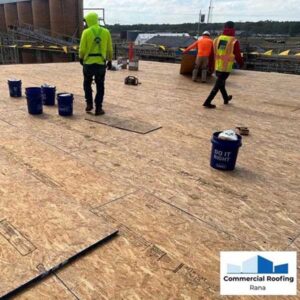
Commercial buildings require proper care and maintenance to ensure their longevity. One of the most crucial aspects of maintaining a commercial property is the condition of its roof. Over time, commercial roofs can deteriorate due to various factors such as age, weather conditions, and material wear and tear. When that happens, it becomes imperative to consider commercial roofing replacement.
Understanding the Need for Roof Replacement
Commercial roof replacement is not a decision that should be taken lightly. It requires careful assessment and understanding of the signs indicating the need for replacement. Ignoring the signs can lead to long-term damage to the building and costly repairs.
When it comes to the safety and integrity of your commercial property, it is crucial to be proactive in identifying the signs of a failing roof. By doing so, you can prevent further damage and avoid potential hazards that may arise from a compromised roof.
Signs Your Commercial Roof Needs Replacement
Identifying the signs of a failing roof is crucial in preventing further damage and avoiding potential hazards. Some common indications that your commercial roof needs replacement include:
- Extensive water damage or leaks in multiple areas
- Widespread deterioration, such as cracked or missing shingles
- Increased energy bills due to insufficient insulation
- Frequent repairs that do not effectively address the underlying issues
These signs should not be taken lightly, as they can be indicative of more serious underlying problems. It is essential to consult with a professional roofing contractor who can assess the condition of your roof and provide expert advice on whether replacement is necessary.
The Lifespan of Commercial Roofs
The lifespan of a commercial roof can vary depending on several factors, including the quality of installation, the type of roofing material used, and the level of maintenance. On average, commercial roofs can last between 20 to 30 years. However, factors such as harsh weather conditions and poor maintenance practices can significantly shorten this lifespan.
Regular maintenance and inspections are key to extending the lifespan of your commercial roof. By addressing minor issues promptly and ensuring proper upkeep, you can maximize the longevity of your roof and avoid premature replacement.
Impact of Weather Conditions on Roofing
The exterior elements have a major impact on the wear and tear of commercial roofs. Different weather conditions pose various challenges, and certain regions are prone to specific weather-related issues.
In areas with heavy snowfall, the weight of accumulated snow can put excessive strain on the roof structure, leading to roof collapse. High winds can cause shingles to become loose or even blow off completely. Intense sunlight and heat can cause materials to deteriorate, leading to cracks and leaks.
Considering the weather conditions in Holly Springs, it is essential to select roofing materials that can withstand the local climate and protect your commercial property effectively. Investing in high-quality materials and ensuring proper installation can help mitigate the impact of weather conditions and prolong the lifespan of your roof.
By understanding the signs indicating the need for roof replacement, the lifespan of commercial roofs, and the impact of weather conditions, you can make informed decisions regarding the maintenance and replacement of your commercial roof. Remember, proactive measures today can save you from costly repairs and potential hazards in the future.
Choosing the Right Roofing Material
Selecting the appropriate roofing material is crucial for a successful roof replacement project. There are various options available, each with its advantages and disadvantages.
Pros and Cons of Different Roofing Materials
1. Asphalt Shingles:
Asphalt shingles are a popular choice due to their affordability and ease of installation. However, they have a shorter lifespan compared to other materials and may require more frequent maintenance.
2. Metal Roofing:
Metal roofs offer exceptional durability and energy efficiency. They are resistant to fire, pests, and rotting. However, they tend to be more expensive upfront.
3. EPDM (Ethylene Propylene Diene Monomer):
EPDM roofs are known for their longevity and resistance to UV rays. They are also relatively simple to install. However, they may not be as visually appealing as other options.
4. TPO (Thermoplastic Olefin):
TPO roofs are highly reflective, making them energy efficient. They are also resistant to mold and dirt accumulation. However, they may require more maintenance in areas with extreme weather conditions.
Consulting with a professional roofing contractor can help you determine the best material for your commercial property based on your specific needs and budget.
Sustainability and Roofing Materials
In recent years, the importance of sustainable roofing materials has grown significantly. Sustainable roofing not only benefits the environment but also provides long-term cost savings.
Options such as metal roofs and cool roofs, which reflect sunlight and reduce energy consumption, contribute to green building practices. Additionally, considering materials with high weather resistance and low maintenance requirements can contribute to the longevity and overall sustainability of your commercial roof.
Cost-effectiveness of Roofing Materials
While choosing the right roofing material for your commercial property, it is essential to consider the cost-effectiveness in the long run. Although certain materials may have a higher upfront cost, they may provide increased durability and lower maintenance requirements, leading to significant cost savings over time.
Evaluating factors such as lifespan, maintenance needs, energy efficiency, and potential insurance discounts can help you make an informed decision about the most cost-effective roofing material for your commercial property.
The Roof Replacement Process
Once you have decided on the roofing material that suits your needs, the roof replacement process can begin. It involves several steps that ensure a successful and long-lasting result.
Initial Roof Inspection and Assessment
The first step of the process is to have a professional roofing contractor conduct a thorough inspection of your commercial roof. This assessment helps identify any underlying issues, determine the extent of damage, and make recommendations for the replacement.
The inspection may include checking for leaks, examining the structure, evaluating insulation, and assessing the condition of the existing roofing material.
Preparing for Roof Replacement
Preparation is key to a smooth roof replacement process. It involves clearing the workspace, protecting surrounding areas from potential damage, and ensuring the safety of workers and occupants.
Additionally, obtaining the necessary permits and coordinating with local authorities are crucial steps to comply with regulations and ensure a hassle-free replacement process.
The Replacement Procedure
The actual replacement process will involve removing the old roofing material and installing the new one. A professional roofing team will carefully execute the replacement, ensuring proper insulation, weatherproofing, and ventilation.
They will also address any structural issues and ensure proper drainage to protect your commercial property from water damage.
Post-Replacement Care and Maintenance
Once your commercial roof has been successfully replaced, it is important to implement a regular maintenance plan to maximize its lifespan and prevent future problems.
Regular Roof Inspections
Scheduling regular roof inspections is crucial in identifying and addressing any potential issues early on. A professional inspector can thoroughly examine the roof, identifying signs of damage or leaks, and recommending appropriate maintenance measures.
Preventive Maintenance Measures
Implementing preventive maintenance measures can help extend the life of your commercial roof and reduce the likelihood of major repairs. Regular cleaning of debris, checking and repairing flashing, inspecting for damages caused by severe weather, and clearing gutters are essential preventive measures.
Dealing with Minor Repairs
Even with proper maintenance, minor repairs may be necessary over time. Promptly addressing small issues, such as leaking seals or cracked shingles, can prevent them from escalating into major problems. If you notice any signs of damage or suspect an issue with your commercial roof, contacting a professional roofer should be a priority.
In conclusion, Holly Springs commercial roofing replacement is a significant undertaking that requires careful consideration of various factors. Understanding the signs indicating the need for replacement, choosing the right roofing material based on sustainability and cost-effectiveness, and following a comprehensive roof replacement process can ensure a durable and long-lasting solution for your commercial property. Regular inspections and maintenance should also be prioritized to protect your investment and maintain the integrity of your commercial roof for years to come.
Don’t let the threat of water damage to your commercial property keep you up at night. Trust the expertise of Commercial Roofing Rana, where we’ve been safeguarding businesses like yours since 1983. Our Platinum-level Duro-Last roofing systems are not just installed; they’re crafted to fit your building perfectly, ensuring superior protection against the elements. From industrial complexes to shopping centers, our licensed professionals are equipped to handle the unique needs of your commercial roof with precision and care. Ready to fortify your property’s first line of defense? Schedule Now! and let Commercial Roofing Rana provide you with a roofing solution that stands the test of time and weather.
